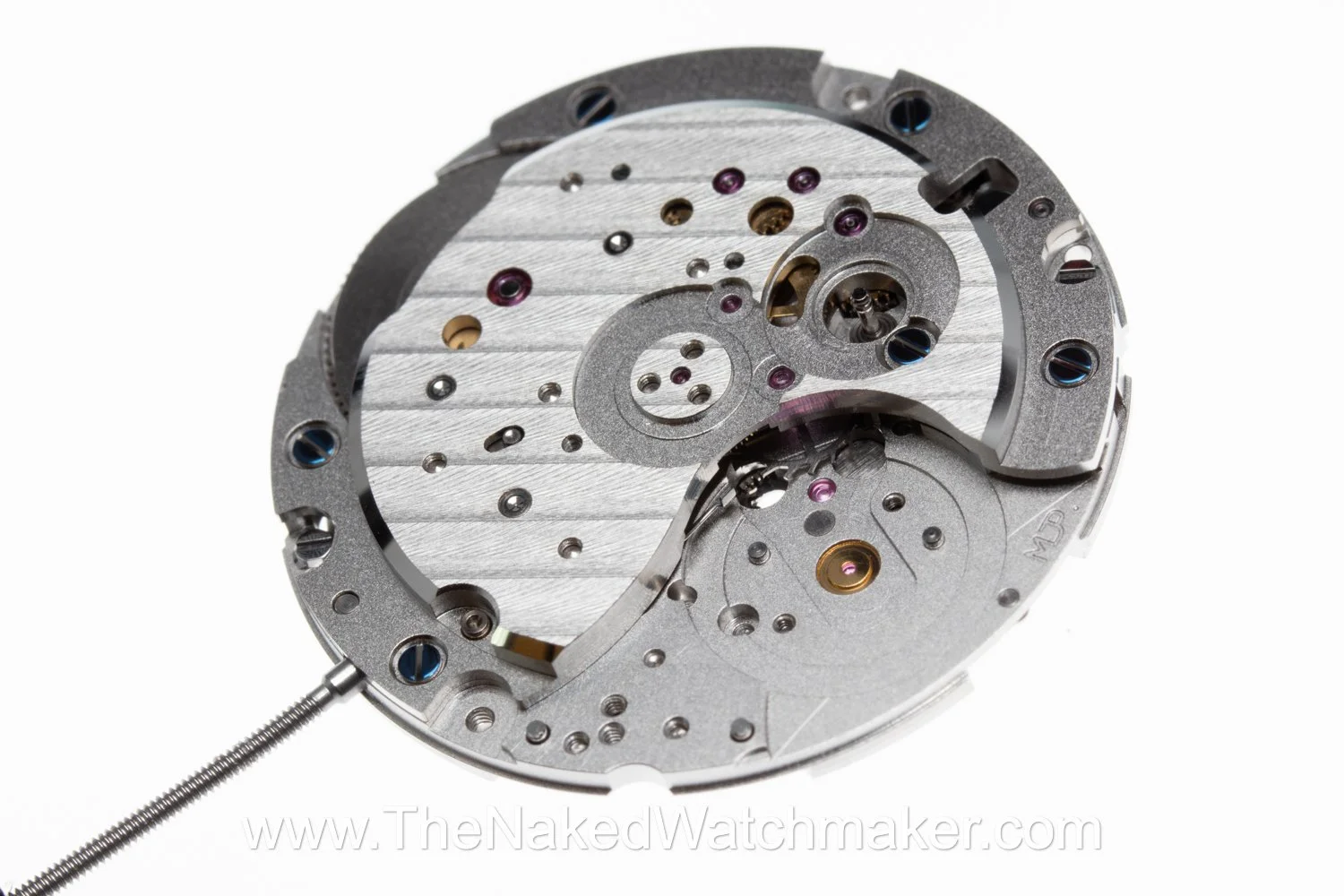The Reason
A new (2021) automatic movement compatible in dimensions with the ETA 2824.
There will exist various different decorative finishes of the G100, the one shown here is made with Geneva strips.
Diameter Ø25.60 mm Height 4.45 mm Frequency 28'800 A/H (4 Hz) Power reserve 68 hours Number of jewels 24 Angle lift of balance 51°
(Soigné is a reference to a higher level version of the movement, graph courtesy of La Joux-Perret SA)
The view from under the dial, the central plate holding in place the calendar mechanism.
A drawing showing the dimensions of the calibre with the tolerances that should be engineered between it and the surrounding case. (Drawing courtesy of La Joux-Perret SA)
The rotor removed from the movement showing the large 3/4 plate that holds in place the majority of the mechanism, and carries the rotor.
The rotor is made from a solid piece of tungsten (heavy metal) and turns on a ball-race held in place with 3 screws.
A drawing of the rotor mass that can eventually be customised by the client. (Drawing courtesy of La Joux-Perret SA)
The form of the balance cock and the large train bridge are both classically influenced from early pocket watch and wristwatch movement designs.
The first drive wheel that meshes with the ball race on the rotor weight is held in place with a ‘C’ clip.
The drive wheel removed and turned around showing the lower pinion that drives the lower automatic train leading to the ratchet wheel winding the mainspring in the barrel.
The barrel partially viewed under the large 3/4 bridge. The step around the bridge allows space for the additional thickness of the rotor weight that oscillates as the watch is worn.
Above the blued screw is a small pin with a hollow in the centre. This piece is connected to the setting lever and when pushed allows the stem to be removed.
In between the two blued screws in the lower cutout is a polished steel plug resembling a screw. This piece is held by a friction fit and when turned will lock the dial feet in place.
The balance wheel and cock assembly removed from the movement, showing the Swiss anchor/lever escapement.
The balance cock and balance wheel. The shock protection for the balance pivots is made by Kiff, one of the two largest producers of shock protection in Switzerland.
The index in the form of an ‘A’ allows for fine adjustment by turning the eccentric plug (resembling a screw) sitting between the lower legs.
The underside of the stud holding the balance spring in place secured with a specialised glue/resin.
Although this system does not allow for adjustment after fixing, providing the balance spring is correctly set the result is no additional tensions on the spring at the point of attachment.
The underside of the index showing the regulating fingers/pins that limit the effective length of the balance spring.
A view of the Swiss lever held in place and to its right the manufactures mark.
The Swiss lever and its bridge.
The main 3/4 bridge removed from the movement showing the mechanism hidden underneath.
All of the wheels shown are made from CuBe (beryllium copper) and un-plated. CuBe work-hardens, is auto-lubricating and doesn’t tarnish, making for a practical material for wheels to be made in.
The lever to the right of the wheels is a click, acting on a lower section of the wheel assembly allowing the automatic train to only turn in one direction.
The sliding pinion in setting position. Meshing with the cut-out in its centre is the hack or brake that stops the balance wheel from turning when the watch is being set.
Recto-verso of the 3/4 bridge
The majority of the wheels removed leaving the barrel and its ratchet wheel in position.
The ratchet wheel is made in CuBe
The main-plate dismantled
During cleaning the setting mechanism and the click system for the automatic train are left in place.
The dial side of the movement with the central disc holding in place the calendar mechanism removed. Below the ‘30’ is the drive spring the moves the calendar disc. Between 9 and 10 is the index that locates the calendar disc after it has been moved.
The series of pinions positioned between 15 and 17 are the rapid date change mechanism.
The setting mechanism
Summary
The G100 is a solid workhorse calibre that can be easily adapted to many different watches due to its compatibility with the ETA 2824. The overall decoration of the model presented here is clean and effectively executed. The extended power reserve is a differentiating characteristic compared to other similar movements. The rotor weight is held in place by 3 screws, is commonly found on higher-level movements.
GALLERY
In the grid below are both images used in the description of this page, plus more. Please click on the image to enlarge and see in full.
To learn more about La Joux-Perret













































































